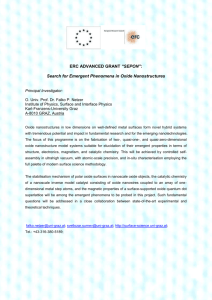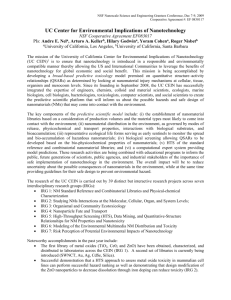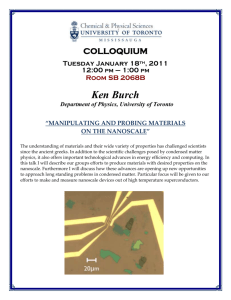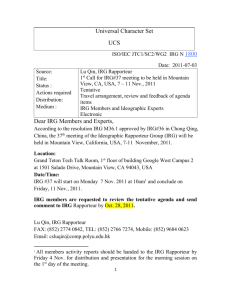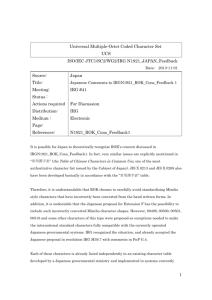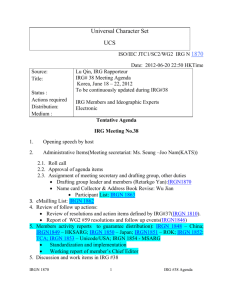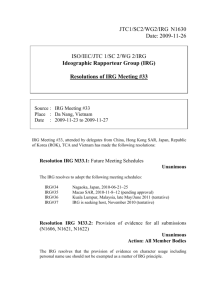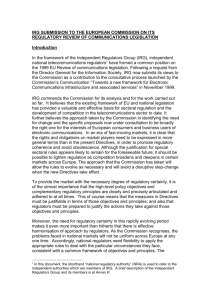2-Summary-Final-GS-MBS - The University of Oklahoma
advertisement
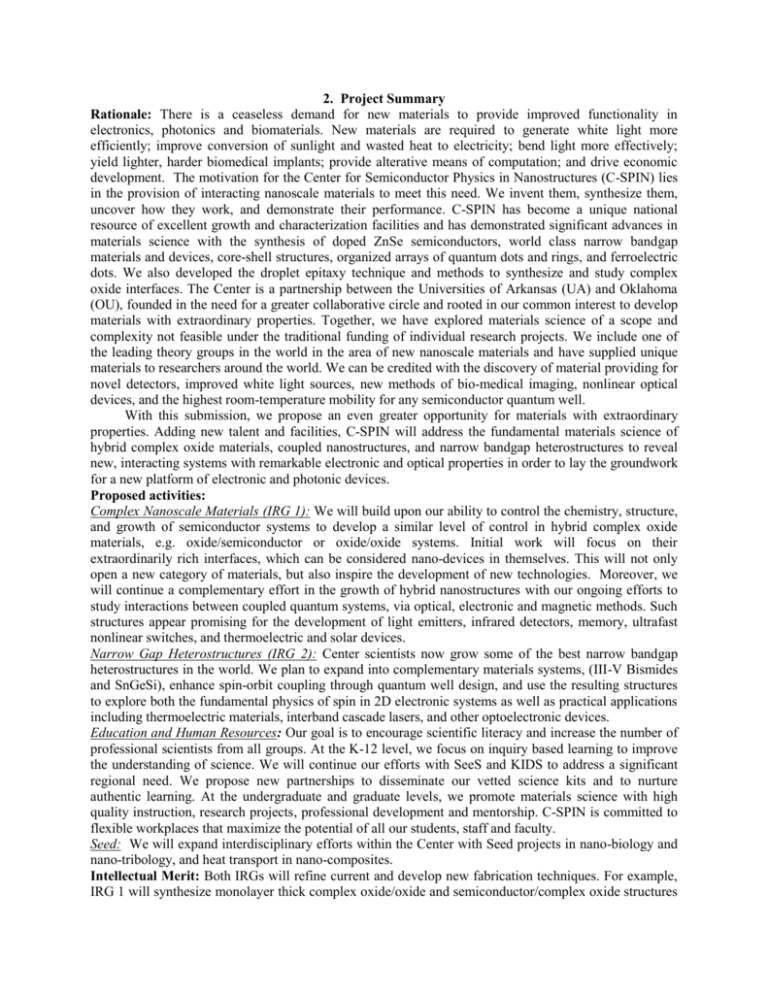
2. Project Summary Rationale: There is a ceaseless demand for new materials to provide improved functionality in electronics, photonics and biomaterials. New materials are required to generate white light more efficiently; improve conversion of sunlight and wasted heat to electricity; bend light more effectively; yield lighter, harder biomedical implants; provide alterative means of computation; and drive economic development. The motivation for the Center for Semiconductor Physics in Nanostructures (C-SPIN) lies in the provision of interacting nanoscale materials to meet this need. We invent them, synthesize them, uncover how they work, and demonstrate their performance. C-SPIN has become a unique national resource of excellent growth and characterization facilities and has demonstrated significant advances in materials science with the synthesis of doped ZnSe semiconductors, world class narrow bandgap materials and devices, core-shell structures, organized arrays of quantum dots and rings, and ferroelectric dots. We also developed the droplet epitaxy technique and methods to synthesize and study complex oxide interfaces. The Center is a partnership between the Universities of Arkansas (UA) and Oklahoma (OU), founded in the need for a greater collaborative circle and rooted in our common interest to develop materials with extraordinary properties. Together, we have explored materials science of a scope and complexity not feasible under the traditional funding of individual research projects. We include one of the leading theory groups in the world in the area of new nanoscale materials and have supplied unique materials to researchers around the world. We can be credited with the discovery of material providing for novel detectors, improved white light sources, new methods of bio-medical imaging, nonlinear optical devices, and the highest room-temperature mobility for any semiconductor quantum well. With this submission, we propose an even greater opportunity for materials with extraordinary properties. Adding new talent and facilities, C-SPIN will address the fundamental materials science of hybrid complex oxide materials, coupled nanostructures, and narrow bandgap heterostructures to reveal new, interacting systems with remarkable electronic and optical properties in order to lay the groundwork for a new platform of electronic and photonic devices. Proposed activities: Complex Nanoscale Materials (IRG 1): We will build upon our ability to control the chemistry, structure, and growth of semiconductor systems to develop a similar level of control in hybrid complex oxide materials, e.g. oxide/semiconductor or oxide/oxide systems. Initial work will focus on their extraordinarily rich interfaces, which can be considered nano-devices in themselves. This will not only open a new category of materials, but also inspire the development of new technologies. Moreover, we will continue a complementary effort in the growth of hybrid nanostructures with our ongoing efforts to study interactions between coupled quantum systems, via optical, electronic and magnetic methods. Such structures appear promising for the development of light emitters, infrared detectors, memory, ultrafast nonlinear switches, and thermoelectric and solar devices. Narrow Gap Heterostructures (IRG 2): Center scientists now grow some of the best narrow bandgap heterostructures in the world. We plan to expand into complementary materials systems, (III-V Bismides and SnGeSi), enhance spin-orbit coupling through quantum well design, and use the resulting structures to explore both the fundamental physics of spin in 2D electronic systems as well as practical applications including thermoelectric materials, interband cascade lasers, and other optoelectronic devices. Education and Human Resources: Our goal is to encourage scientific literacy and increase the number of professional scientists from all groups. At the K-12 level, we focus on inquiry based learning to improve the understanding of science. We will continue our efforts with SeeS and KIDS to address a significant regional need. We propose new partnerships to disseminate our vetted science kits and to nurture authentic learning. At the undergraduate and graduate levels, we promote materials science with high quality instruction, research projects, professional development and mentorship. C-SPIN is committed to flexible workplaces that maximize the potential of all our students, staff and faculty. Seed: We will expand interdisciplinary efforts within the Center with Seed projects in nano-biology and nano-tribology, and heat transport in nano-composites. Intellectual Merit: Both IRGs will refine current and develop new fabrication techniques. For example, IRG 1 will synthesize monolayer thick complex oxide/oxide and semiconductor/complex oxide structures and uncover the physics of the interface and how it can control material behavior. IRG 2 will advance high-mobility narrow bandgap semiconductors, expanding the selection of materials to be grown and the scope of material issues to understand. These techniques, valuable in themselves, will also advance our knowledge of basic physics and present opportunities for novel device design. IRG 1 promises potential memory elements, electro-optical media, light emitters, detectors, and a new direction for electronics beyond silicon. IRG 2 will explore applications of narrow bandgap materials that address energy conversion, including thermoelectric and photovoltaic devices, while the enhanced spin effects provide an additional opportunity for spintronic devices. Each IRG has been organized as a team with a proven track record. C-SPIN is rare in its breadth of nano-fabrication techniques (from molecular beam epitaxy to colloidal growth to the use of anodized aluminum oxide templates), its wealth of materials systems (III-V, II-VI, IV-VI, and IV semiconductors and complex oxides) and its diversity of characterization tools. We are well poised to capitalize on our previous achievements to succeed in our proposed directions. Broader Impact: C-SPIN has had a huge impact on the regional academic and industrial environment. On the state level we provide R&D tools at the nanoscale for regional industry, skilled labor and partnerships with academia. For example, a new 70,000 ft2 Arkansas Nanoscale Materials Science and Engineering building will open in January 2011 and be the home of a new Department of Materials Science and Engineering, OU and UA will each hire two faculty in the nanomaterials area, user facilities will take hold on both campuses, and several national conferences will be held. We will continue to play a regional role in science education through the promotion of inquiry based learning via K-12 student outreach and teacher training; support undergraduate and teacher materials research; and will further increase the participation of underrepresented groups. We will offer quality research experiences for high school teachers and undergraduates in our laboratories, develop a consortium of across-campus programs at both institutions and provide inquiry based science modules for classroom use. By improving science education, enhancing minority participation in science, promoting careers in materials science, and assisting local industry, we will not only train the next generation of scientists and engineers, we will also sow the seeds for the economic development of our region. Added Value of Center: The proposed research is broad and complex and goes beyond the resources of the individual investigator and even the OU or UA campus alone. To learn how to grow and to fully understand unique materials requires an iterative cycle of growth, characterization, experimentation, and modeling using a significant number of researchers, expertise, and instrumentation brought together by the Center. While the materials and underlying science are different in the two IRGs, there is substantial overlap in the basic tools for growth and characterization that brings success to both. Finally, C-SPIN will continue to have a large impact on the development of materials science in both states. The Center will improve the industrial and academic infrastructure of our traditionally low-tech region, and continue to elevate science education and outreach in an underserved area of the country. Industrial and International Partnerships: C-SPIN’s outstanding shared facilities and the unique materials produced by C-SPIN enable many external collaborations with industry (e.g. Intel, Amethyst, IBM, and Texas Instruments), national laboratories (e.g. Argonne, Sandia, and Oak Ridge) and international partners (e.g. Humboldt Universität, São Carlos Universidade, and Tohoku University). We will also continue to work with local spin-off companies, including Phononic Devices (OK), NN Labs (AR), and Nanomech (AR). Administration: C-SPIN will be run by its director (Johnson), IRG directors (Salamo and Santos), and the supervising faculty for industrial (Vickers) and educational (Mullen) outreach. Since the Center spans two universities, we will continue to make use of teleconferencing facilities for our meetings and seminars. Our annual graduate student research days will continue to take place at alternating institutions. An External Review Board with members from state agencies, industry and academia, will continue to receive yearly written reports on each IRG, and conduct biennial site visits. Organizational Commitment: C-SPIN will have 4 faculty hires related to Center initiatives (2 OU/2 UA) and 2 new technical staff positions and a total of $570K in institutional funds (30% of NSF request) to support this work. This displays significant institutional commitment from both universities in recognition of the significant impact that C-SPIN has already created.
